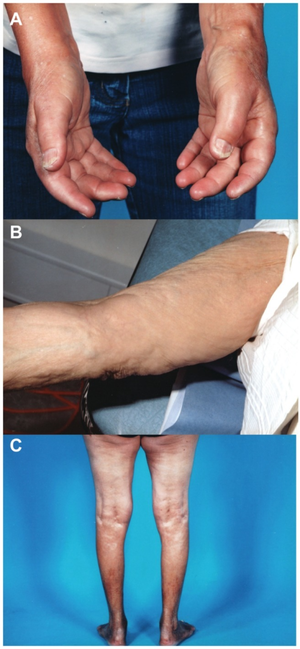We need you! Join our contributor community and become a WikEM editor through our open and transparent promotion process.
Nephrogenic systemic fibrosis
From WikEM
Contents
Background
- Rare but serious scleroderma-like condition associated with gadolinium (MRI contrast) exposure in patients with renal impairment (e.g. hemodialysis, peritoneal dialysis, transplant)
- Risk with any renal impairment, acute or chronic, does not have to have ESRD
- Poorly understood pathogenesis
- Chronic, progressive condition with rare cases of resolution in cases of return of renal function
Associated Illnesses
Clinical Features
- History of HD, PD, renal transplant
- Gadolinium exposure, with timeline of symptom onset variable
- Develops days to years after gadolinium exposure
- Chronic, progressive
- Skin becomes tight, thick, shiny, and indurated skin, with fibrotic nodules and plaques and brawny hyperpigmentation
- Painful, pruritic
- Peau d'orange appearance
- Extremities most commonly affected, followed by trunk. Face rarely involved
- Flexion contractures when lesions overlie joints, limited range of motion
- Hand stiffening
- Extremities more commonly affected than trunk
- Neuromuscular involvement can occur
- In most severe cases, fibrosis involves internal organs (heart, lungs, liver)
Differential Diagnosis
- Scleroderma, morphea
- Calciphylaxis, which may coexist
- Cellulitis
- Necrotizing fasciitis
- Porphyria
- Eosinophilic fasciitis
Evaluation
- No particular lab or imaging diagnostics
- Deep skin biopsy, including dermis, subQ fat, fascia
Management
- No specific management, supportive care
- Treatments anecdotal and of minimal benefit
- Extracorporeal photopheresis (ECP)
- UV phototherapy
- Immunotherapy
- No surgical role except renal transplant
Disposition
- Discharge (does not inherently require inpatient care)
- Follow up with dermatologist for deep skin biopsy
- Follow up with nephrologist for renal disease management
See Also
External Links
References
- Scheinfeld NS et Al. Nephrogenic systemic fibrosis. eMedicine. Updated Feb 8, 2016. http://emedicine.medscape.com/article/1097889-overview.

